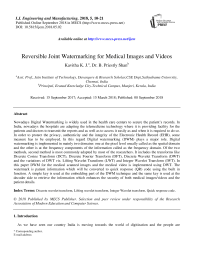Reversible joint watermarking for medical images and videos
Автор: Kavitha K. J., B. Priestly Shan
Журнал: International Journal of Engineering and Manufacturing @ijem
Статья в выпуске: 5 vol.8, 2018 года.
Бесплатный доступ
Nowadays Digital Watermarking is widely used in the health care centers to secure the patient’s records. In India, nowadays the hospitals are adapting the telemedicine technology where it is providing facility for the patients and doctors to transmit the reports and as well as to access it easily as and when it is required to do so. In order to protect the privacy, authenticity and the integrity of the Electronic Health Record (EHR), some measure has to be employed. In this regard Digital watermarking (DWM) plays a major role. Digital watermarking is implemented in mainly two domains: one at the pixel level usually called as the spatial domain and the other is at the frequency components of the information called as the frequency domain. Of the two methods, second method is most commonly adapted by most of the researchers. It includes the transforms like Discrete Cosine Transform (DCT), Discrete Fourier Transform (DFT), Discrete Wavelet Transform (DWT) and the variations of DWT viz. Lifting Wavelet Transform (LWT) and Integer Wavelet Transform (IWT). In this paper DWM for the medical scanned images and the medical video is implemented using DWT. The watermark is patient information which will be converted to quick response (QR) code using the built in function. A simple key is used at the embedding part of the DWM technique and the same key is used at the decoder side to retrieve the information which enhances the security of both medical images/videos and the patient details.
Discrete wavelet transform, Lifting wavelet transform, Integer Wavelet transform, Quick response code
Короткий адрес: https://sciup.org/15015858
IDR: 15015858 | DOI: 10.5815/ijem.2018.05.02
Список литературы Reversible joint watermarking for medical images and videos
- A. Ai-haj, “Combining Cryptography and Digital Watermarking for Secured Transmission of Medical Images,” 2016.
- C. Engineering and C. Engineering, “A security technique based on watermarking and encryption for MI,” pp. 3–6, 2015.
- A. Babu, “A Reversible Crypto-Watermarking System for Secure Medical Image Transmission,” pp. 1–6, 2015.
- C. Su, J. Huang, C. Shih, and Y. Chen, “Reversible and Embedded Watermarking of Medical Images for Telemedicine,” pp. 145–150, 2015.
- M. S. Hassanein, “Secure Digital Documents Using Steganography and QR Code,” no. November, 2014.
- D. Cho, “A Study on Effective Digital Watermarking Method Suitable for QR code,” vol. 51, pp. 94–97, 2014.
- J. Waleed, H. D. Jun, S. Saadoon, and S. Hameed, “An Immune Secret QR-Code Sharing based on a Twofold Zero- Watermarking Scheme,” vol. 10, no. 4, pp. 399–412, 2015.
- J. Chen, W. Chen, and C. Chen, “Identification Recovery Scheme using Quick Response ( QR ) Code and Watermarking Technique,” vol. 596, no. 2, pp. 585–596, 2014.
- L. Laur, P. Rasti, M. Agoyi, and G. Anbarjafari, “A Robust Color Image Watermarking Scheme Using Entropy and QR Decomposition,” vol. 24, no. 4, pp. 1025–1032, 2015.
- N. I. Yassin, N. M. Salem, and M. I. El Adawy, “Medical Video Watermarking Scheme for Electronic Patient Records,” vol. 76, no. 1, pp. 12–17, 2013.


